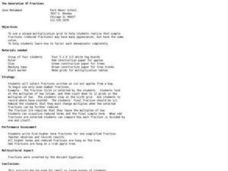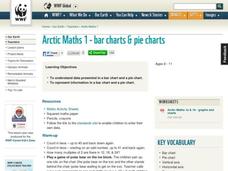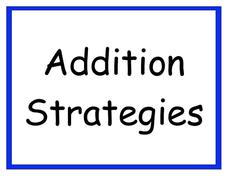Curated OER
The Generation of Fractions
Pupils explore the process of reducing fractions to simplest form by using a multiples grid. In this simplest form lesson, students pull different fractions out of a bag and then consult their grid to discover all the multiples that...
Curated OER
Who Has More?
Learners engage in a lesson that is concerned with the standard of comparing the quantities of whole numbers using different strategies from the concrete to the abstract. They count objects and compare them, use symbols of comparison,...
Curated OER
Secret Sequences
Students are exposed to different types of sequences. in this sequencing lesson, students learn about simple sequences, multiplication sequences, declining sequences, the Fibonacci sequence and other sequences.
World Wildlife Fund
Bar Charts & Pie Charts
Learn about life in the Arctic while practicing how to graph and interpret data with this interdisciplinary lesson plan. Starting with a whole group data-gathering exercise, students are then given a worksheet on which they analyze and...
Math Learning Center
Addition Strategies
Help young mathematicians refer to simple addition strategies with a set of math posters. The pages feature ways to remember how to add zero to a number, how to determine if a number is odd or even, and making fast tens.
Curated OER
Opposite Grapevines
There are really only four basic moves in this line dance. Those dance moves are: grapevine, slide, marching, and then dipping and clapping. Each 8-count is repeated twice, for a total of a 64-count dance. The unique addition to this...
Computer Science Unplugged
Card Flip Magic—Error Detection and Correction
I can find the error in an array of cards? After watching a demonstration class members search for the error is the provided cards. The resource provides a real-life example of using ISBN numbers in error detection and using check...
Education Development Center
Consecutive Sums
Evaluate patterns of numbers through an engaging task. Scholars work collaboratively to determine a general rule reflecting the sum of consecutive positive integers. Multiple patterns emerge as learners explore different arrangements.
Curated OER
Number Worksheets
In this number recognition worksheet, students study the numbers in each set and write the missing number on the blank line.
Curated OER
In and Out Function
Third graders examine how to solve in and out function problems, or mystery numbers. They analyze a variety of mystery number problems together and extend the patterns. Students then independently complete a Mystery Number activity...
Curated OER
Round Each Number to the Nearest 100
In this math worksheet, students round 3 digit numbers to the nearest 100. In the chart students analyze the 3 digit number, check whether it should be rounded up or down, then write the rounded number.
Curated OER
Building Patterns Incrementally
Students study the recurrence rules for patterns where the increase from one term to the next is not constant. They look for the recurrence rule on their own. They copy the pattern and create the next element, continue the pattern with...
Curated OER
Patterns Relationship
In this patterns worksheet, students answer multiple choice questions about patterns containing one to four digit numbers. Students complete 10 multiple choice questions.
Curated OER
Probability
In this probability worksheet, 8th graders solve 10 different problems that include determining various events of probability. First, they determine the odds of an event given the ratio. Then, students use a fraction to express the...
Scholastic
Study Jams! Median
Zoe is curious how many goals her soccer team usually scores in a game. To answer the question, she walks through the process of finding the median of a data set in this step-by-step presentation. Examples are included that model how to...
Curated OER
Making Math More Fun
Trick young mathematicians into practicing their basic arithmetic with this extensive collection of fun math games. Whether you're teaching addition, subtraction, multiplication, division, place value, or even fractions, there is a...
NY Learns
Investigation - What's in the Bag?
If you have or can create a set of tiles, numbered one through eight, then you can implement this hands-on lesson about probability models. Individuals draw a tile from a bag, record its number, and then return it to the bag. They...
Curated OER
Calories in a sports drink
How much can a company round numbers without being misleading? Learners investigate the accuracy of claims made by a sports drink company. Teachers could easily modify the activity by bringing in their own beverage bottles, or by taking...
Curated OER
Dorm Problem
In this algebra worksheet, students solve a word problem figuring out how many rooms there are in dorm with an odd number. This worksheet contains an answer key.
Curated OER
Cards to 24
Third graders practice with a deck of cards to play a version of the math game 24. They use four cards and combinations of the four arithmetic operations to try to make a total of 24. Each student writes and solves problems which...
Curated OER
Beetle Wheels
Second graders link the development of skip-counting patterns to bars on a relationship graph. They also plot our skip-counting patterns on a hundred's board, counting by 2's and also by 4's.
Illustrative Mathematics
Double Plus One
Practice doubling with a straightforward worksheet. Learners double plus one each number in the table, and then answer a series of hypothetical math equations.
Curated OER
Stand Up and Be Counted
In this number recognition instructional activity, students take part in a game where they stand up if they are an even number. Students seated count off again and only even numbers stand up. Students then complete three questions for...
Curated OER
Square and Triangular Numbers
Young scholars use equations to represent practical situations. They solve linear equations and quadratic equations. The use of problem solving strategies is also developed.























